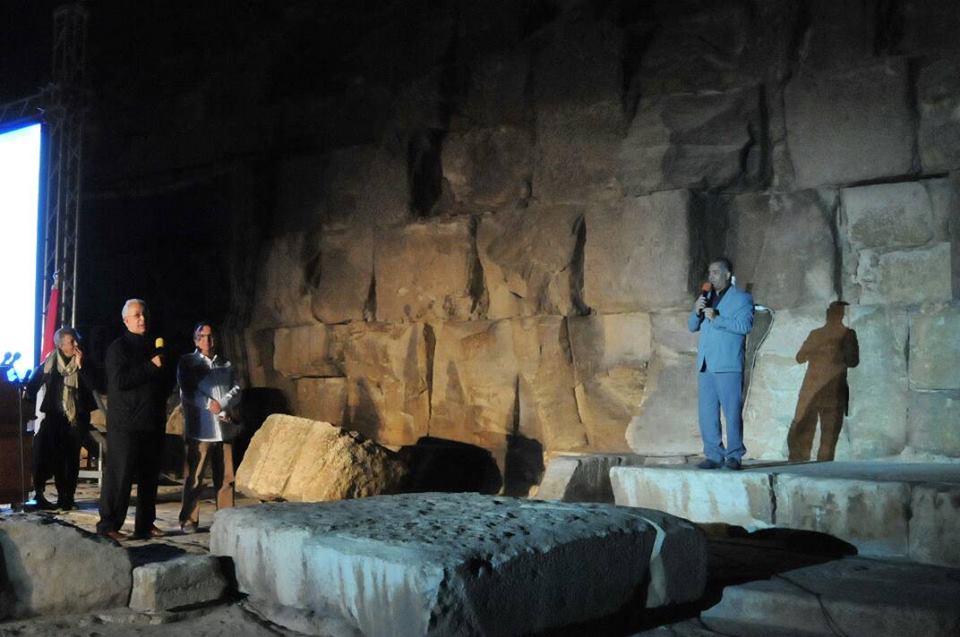Latest NEWS
- Aswat Masriya, the last word
- Roundup of Egypt's press headlines on March 15, 2017
- Roundup of Egypt's press headlines on March 14, 2017
- Former Egyptian President Hosni Mubarak to be released: lawyer
- Roundup of Egypt's press headlines on March 13, 2017
- Egypt's capital set to grow by half a million in 2017
- Egypt's wheat reserves to double with start of harvest -supply min
- Roundup of Egypt's press headlines on March 12, 2017
'Non-conventional thermal shapes' discovered in Great Pyramid, further studies needed

Images from the press conference held at the Giza Plateau on to reveal the latest findings of the international project to scan several Ancient Egyptian pyramids, on Monday, Nov. 10, 2015. Photo provided by ministry of antiquities
CAIRO, Nov. 10 (Aswat Masriya) - Using infrared rays to scan the eastern side of the Great Pyramid, scientists were able to find a very characteristic "non-conventional thermal shape" in the Great Giza Pyramid at the ground level, Egypt's minister of antiquities said on Monday.
The Great Pyramid of Giza is the only surviving site of the seven ancient wonders of the world.
It is still unclear what these shapes mean but they may lead to further "unraveling" the "secrets of the pyramids."
The scanning was carried out in a live event covered by the local and international press at the Giza plateau, which for centuries bore Ancient Egyptian historic wonders, including the three famed Giza pyramids.
Minister Mamdouh al-Damaty said in a press conference held at the site that the team identified differences in the temperatures of two adjacent limestones, with different characteristics, according to a statement issued by the ministry on its Facebook page.
The infrared team found a space in this area containing several stone blocks, with each separated from the adjacent block by six degrees.
"This raised many questions," the minister said, adding that this requires further studies to explain the phenomenon.
Damaty believes that there is something resembling a passage, with these stone blocks right in front of it, suggesting that there might be something behind those blocks but he said he cannot predict or reveal what it is until all studies are complete.
Damaty said that after the thermal scan, different techniques will be used, relying on the latest available scientific technology to discover "unknown archeological details and facts."
All non-conventional thermal shapes have been noted, he said, adding that the data collected in this phase will be subject to further analysis using three-dimensional imaging to prepare for the next phase of the project, which is due in weeks.
The pyramid scan using infrared rays is the first phase of an international joint project that will continue until the end of 2016, announced the antiquities minister last month.
Other than the Great Pyramid of Giza, it includes three more pyramids, the Red Pyramid and the Bent Pyramid of Dahshur, which lies about 40 kilometres south of Cairo and the Pyramid of Khafre, the second largest of the three Giza pyramids.
Cairo University Professor Hany Helal, the project's chief coordinator, said at the time of the announcement that there are four "non-detrimental" surveying methods that will be used in the project: muon particle radiography, cosmic radiography, thermal imaging using infrared rays and optical surveying followed by three-dimensional remodeling.
What is now modern-day Egypt was once home to the Pharaonic civilisation which spanned several dynasties and is one of the oldest civilisations in history.
The project intends to use non-invasive and non-destructive techniques to discover more about the mysteries left behind by Ancient Egyptians.
The project brings together the Egyptian ministry of antiquities, Cairo University's faculty of engineering, the Paris-based Heritage Innovation Preservation Institute and multiple other partners.










